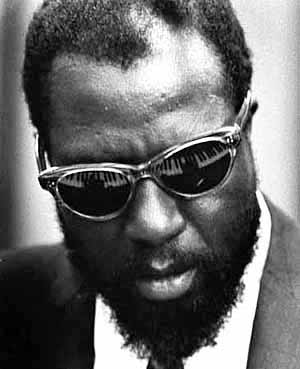In such a community with a myriad of
ethnicities, there also came a more cosmopolitan atmosphere. This atmosphere
came about as a result of the exposure to so many cultures, as did a certain
energy that lent itself to jazz. With
the open and enthusiastic celebration of such differing cultures, and that energy,
there came competition. The interracial mixing, but also fighting, that went on
in that area of New York created a musical heterodoxy in Monk’s work. His offbeat and avante garde way of playing
was modern & eccentric; he had a very individualistic and idiosyncratic
style that was clearly influenced by his diverse surroundings. San Juan Hill was much too small for
comfortable living, but Monk could not afford to move out, and so he was in the
belly of the neighborhood, which itself was in the belly of New York; he
couldn’t avoid the influence of such a city (Stewart lecture).
Monk’s transcendence of race can be
summarized in the interview in which he insisted “that he doesn’t think about
race but rather sees himself as an American. But being an American…“doesn’t
prevent me from being aware of all the progress that still needs to be made…I
know my music can help bring people together, and that’s what’s important”
(Kelley 335). He did not focus on the
problem of racism, but overcame it in his dedication to making jazz music, as
he saw it as a way to eventually lead to a “friendship” of cultures in the
United States. Kelly writes, as Larry
Ridley recalled, “contrary to that attempt to portray him as some people did as
weird or whatever, he was a very bright and brilliant person.... I
remember telling Thelonious how I was sick of whites calling us ‘boys’ and
stuff like that. He said, ‘Ain't no drag, Larry, because everybody wants
to be young’” (Kelley 417).
As Monk was subjected to racism,
especially from the cops of New York and elsewhere, the loss of his cabaret
card and his arrest in Delaware with Nica, he still refused to respond by
becoming more race conscious. This added
a poignancy to his stance in that it only strengthened his resolve to stay out
of the race conversation and speak through his music only. As Dr. Stewart said
in lecture, “His success in transcending race and class lines is perhaps
embodied in his affectionate relationship with Nica (Kathleen Annie Pannonica
Rothschild), but also the way in which he adopted and became adopted by a young
generation of Blacks and Whites who were rebelling against the strictures of
American society.”
Monk’s music captivated a freethinking
community that was not solely black. It exemplified the concept of a new
community of “artistic souls” that rebelled against middle class conventionality. “That community was very small at first, but
grew and blossomed, and laid the ground for his tenure at the Five Spot in
1957, where the owners said Monk could be there ‘as long as he wanted’”
(Stewart lecture). This community
embraced him any others with open arms and a yearning for individuality as well
as a intrinsic sense of belonging. According
to Dr. Stewart, “Monk used his art to create a new community, a bohemian
community bound together by a tolerance for modernity, for dissonance in music
and for the avant garde in art and life.”

No comments:
Post a Comment